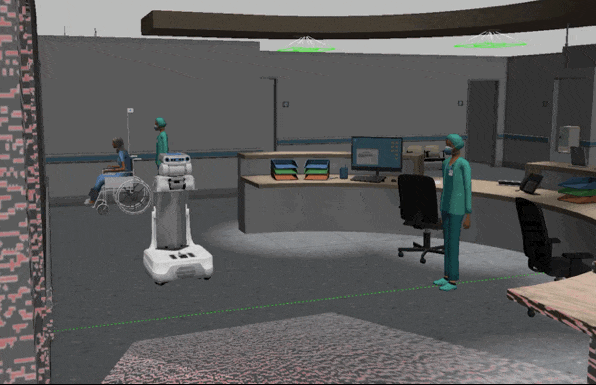AWS Robotics Blog
Category: *Post Types
Deploying ROS applications as Snaps with AWS IoT Greengrass 2.0
AWS recently announced the release of AWS IoT Greengrass 2.0, an edge runtime that offers added flexibility in deploying containerized applications than its predecessor. In this blog, we’ll explore why this improvement is useful for the robotics community, and walk through how you package and deploy Robot Operating System (ROS) applications to devices using AWS IoT Greengrass 2.0.
Testing map generation at scale with 3D worlds from AWS WorldForge
In this blog, learn about AWS RoboMaker WorldForge, and how 3D world generation can be used to streamline testing and training of core robotic algorithms at scale.
Testing a PR2 Robot in a simulated Hospital World
Nowadays, risk of spreading disease is a key concern in hospitals, where doctors, nurses and other caregivers are on the front lines helping patients. Hospitals have started using robots in daily operations such as contactless delivery and room disinfection to reduce risk of spreading disease. As the need for robots in healthcare grows, better tools are needed to build, test, and deploy robotics applications quickly and safely. Amazon Web Services (AWS) has developed a Gazebo simulated Hospital World and published it as open source so that robotics companies within the Healthcare industry can more easily test their robots in a simulated hospital environment. In this blog, I will provide an overview of the hospital and share my experience using it to test a PR2 robot, including software failures that I encountered that you may find helpful.
Build an Alexa controlled robot with AWS RoboMaker
This blog references AWS RoboMaker Integrated Development Environment (IDE), a feature that has been deprecated. To follow along with this blog post, use the AWS Cloud9 IDE. See our updated blog on how to Build and simulate robotics applications in AWS Cloud9. Introduction Alexa is Amazon’s cloud-based voice service and Alexa-compatible devices allow users to […]
Navigating robots on Mars: Results of the AWS JPL Open Source Rover Challenge
Earlier this year, we held the AWS JPL Open Source Rover Challenge, a four-month competition where participants from around the world used deep reinforcement learning to drive digital robot models on a virtual Mars landscape. Participants created autonomous navigation models for the robot and trained them in AWS RoboMaker simulation. The virtual robot used in […]
Easily record and store robotic application data with the S3 rosbag cloud extension for AWS RoboMaker
The S3 rosbag cloud extension enables customers to easily configure and record data from robots as rosbags, and upload them to Amazon S3, which they can later use to analyze events, troubleshoot existing applications, and provide as inputs to AWS RoboMaker log-based simulation for regression. In this blog, we will review three ROS nodes in the S3 rosbag cloud extension that create and upload rosbag files from the robot to Amazon S3, with hands-on examples of how to use the nodes.
Introduction to Automatic Testing of Robotics Applications
This blog will explore best practices for testing and validation of robotics and autonomous systems running Robot Operating System (ROS) software. We will review how developers can increase their feature velocity and reduce errors by using simulation-based testing.
ROS 2 Foxy Fitzroy: Setting a new standard for production robot development
The highly anticipated Robot Operating System 2 distribution Foxy Fitzroy (ROS 2 Foxy) has been released. ROS 2 Foxy is the most secure and reliable ROS distribution to date for production robotics application development. In this blog, we highlight key features and improvements available in this new release.
Building Robot Operating System (ROS) 2.0 powered robots with the ROSBot 2.0 tutorial and Amazon Web Services (AWS)
The AWS robotics team works with different robotics hardware and software providers to make it easy for developers to build using the Robot Operating System (ROS). This blog discusses robotics reference hardware platforms and a tutorial from Husarion that developers can use to build robotics applications built on the ROS 2 Dashing Diademata distribution.








